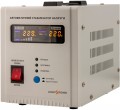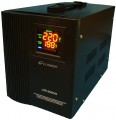Power
The maximum active load power allowed for this model.
Active power is the power that in AC appliances is spent on useful work or on heat generation. In addition to it, such devices also consume reactive power — it goes to the operation of specific components, primarily capacitors and inductors. Apparent power, denoted in volt-amperes (kilovolt-amperes), is the sum of active and reactive, see below about it. Here we note that in simple everyday situations, there is enough data on active power indicated in watts for calculations. In particular, it is this parameter that is considered the key when choosing stabilizers
for washing machines and
dishwashers : in the first case, power from 2 to 5 kW is considered optimal, in the second — from 1.8 to 2.5 kW.
Anyway, the total active power of the connected load should not exceed the figures indicated in the characteristics of the stabilizer. For a full guarantee, it's ok to take a certain margin, but this margin should not be too large — an increase in the allowable power significantly affects the dimensions, weight and price of the device. Also note that there are formulas that allow you to convert the active power consumption into total power, taking into account the type of connected electrical appliance; these formulas can be found in special sources.
Power
Maximum apparent load power allowed for this model
In electrical engineering, full power is called, which takes into account both active and reactive power; the first type of power is discussed above, and the second can be described as the effect of windings, inductors and capacitors on the operation of AC networks. Apparent power is the main parameter for calculating loads on equipment in professional electrical engineering; it is usually denoted in volt-amperes (VA), in the case of stabilizers — in kilovolt-amperes (kVA). Note that for convenience, different types of power in electrical engineering are denoted by units with different names. That is why the power in W indicated in the characteristics of the stabilizer is usually not equal to its power in VA.
When choosing a stabilizer for some household appliances, it is quite enough to have active power data, but if possible it is better to use the full one. In particular, it is this parameter that is key when looking for
a stabilizer for a refrigerator or
a stabilizer for a boiler : in the first case, 0.4 – 1 kVA is considered the optimal value, in the second — from 0.1 to 0.7 kVA. However, anyway, it is necessary to choose a specific model in such a way that its total power is not lower than the total power of the entire connected load — and it is better to have a reserve (in case of unforeseen circumstances or connecting additional eq
...uipment). At the same time, note that powerful models are distinguished by large dimensions and weight, and most importantly, high cost; therefore, it does not always make sense to chase the maximum numbers.
Also note that there are formulas that allow you to derive the optimal total power of the stabilizer based on data on active power and type of load; they can be found in special sources.Input voltage range
The voltage range at the input of the stabilizer, at which it is able to operate in normal mode and supply a constant voltage of 230 or 400 V to the load (depending on the number of phases, see above). The wider this range — the more versatile the device, the more serious power surges it can extinguish without going beyond the standard operating parameters. However, note that this parameter is not the only, and not even far from the main indicator of the quality of work: a lot also depends on the accuracy of the output voltage and the response speed (see both points below).
Also note that some models may have several modes of operation (for example, with 230 V, 230 V or 240 V output). In this case, the characteristics indicate the "general" input voltage range, from the smallest minimum to the largest maximum; the actual ranges for each particular mode will vary.
In addition, there are stabilizers that can operate outside the nominal input voltage range: with a slight deviation beyond its limits, the device provides relatively safe output indicators (also with some deviations from the nominal 230 or 400 V), but if the drop or rise becomes critical, it works appropriate protection (see below).
Output voltage accuracy (±)
The largest deviation from the nominal output voltage (230 V or 400 V, depending on the number of phases), which the regulator allows when operating in the normal input voltage range (see above). The smaller this deviation, the more efficiently the device works, the more accurately it adapts to “changes in the situation” and the less voltage fluctuations the connected load is exposed to.
When choosing for this parameter, it is worth considering first of all how demanding the connected devices are for voltage stability. On the one hand, high stability is good for any device, on the other hand, it usually means a high price. Accordingly, it usually does not make sense to buy an advanced stabilizer for an unpretentious load like light bulbs and heaters, but for sensitive devices like audio systems or computers, it can be very useful.
Cooling
The method of heat removal from the heating elements of the stabilizer.
— Passive. Passive cooling is any type of cooling that does not provide forced heat removal and is carried out only due to natural heat transfer and convection. In low-power stabilizers of this type, the cooling system as such may be completely absent — the amount of heat generated is relatively small, and the natural thermal conductivity of the case and the parts themselves is quite enough to dissipate it into the environment. In more advanced models, radiators can be installed. The main advantage of any passive cooling is the complete absence of noise. In addition, such systems are inexpensive, do not consume energy, take up relatively little space and are very reliable — there is simply nothing to break there, in most cases. On the other hand, they are significantly inferior to active cooling in terms of efficiency, and therefore are poorly suited for powerful devices, especially thyristor and triac (see "Type").
— Active. Active cooling involves the forced removal of heat from the components of the device. This is usually done by combining heatsinks with fans that "blow" excess heat out of the case. Such systems have extremely high efficiency, they can be used in stabilizers of any power, and for semiconductor models (see "Type") active cooling is simply irreplaceable. However, the cost of this efficiency is a high noise level, as well as significant dimensions and weight, which ac...cordingly affect the entire device. Fans tend to draw dust into the case, so you need to monitor them and periodically clean the “hardware” of the stabilizer; and if the fan fails, all cooling, in fact, fails. In addition, the cost of such systems is significantly higher than that of passive ones.

